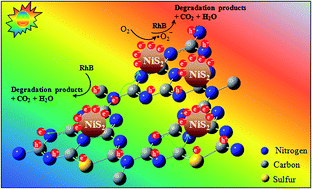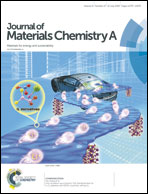Facile synthesis of NiS2 nanoparticles ingrained in a sulfur-doped carbon nitride framework with enhanced visible light photocatalytic activity: two functional roles of thiourea†
Abstract
A one-step, simple and low-cost strategy toward production of novel NiS2/S-doped g-C3N4 (NiS2/CNS) composites was successfully accomplished. The hybrid photocatalyst materials with different amounts of NiS2 nanoparticles (NPs) were successfully in situ synthesized via thermal condensation of a mixture containing thiourea and nickel(II) nitrate. Interestingly, thiourea showed two very important roles: (i) thiourea not only acted as a precursor to in situ produce sulfur-doped carbon nitride materials, but also (ii) the sulfur atmosphere that originated from polycondensation of thiourea provided a sulfur source for in situ production of NiS2 nanoparticles as a non-noble metal sulfide on the CNS sheets during the synthesis. Density functional theory (DFT) computations were carried out to estimate the preferred position of S atoms within the backbone of the CNS framework as well as to compare the band gaps and partial density of states (PDOS) spectra. The NiS2 NPs ingrained in the CNS phase increased the efficient charge transport via a heterojunction interface and obviously decreased the recombination of electron–hole pairs evidenced by photoelectrochemical and photoluminescence measurements. Moreover, the band structures of NiS2 as a Mott insulator were studied through electrochemical methods. It was also found that the optimal NiS2 loading value in the NiS2/CNS composites was 5.9 wt% having a reaction rate constant equal to 0.011 min−1, which was about 3.1 and 26.1 times faster compared with those of the CNS (0.0035 min−1) and bulk g-C3N4 (0.00042 min−1) toward degradation of Rhodamine B (RhB) under visible light irradiation. The optimized photocatalyst was capable of showing a high efficiency for phenol photodegradation as a light insensitive pollutant. Hence, the synergistic effects originating from combining sulfur doping and in situ growing of NiS2 NPs in one material enhanced the physicochemical properties of carbon nitride materials. Our results might offer new insight into the cost-effective and simple designing of a photocatalyst using a bi-functional precursor such as thiourea so that it could easily be used on a large scale and even in industrial catalyst production.



 Please wait while we load your content...
Please wait while we load your content...